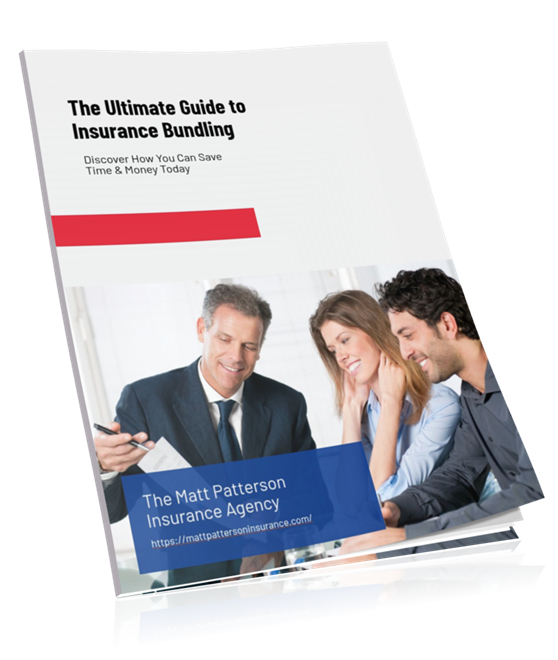If you’ve noticed that bills are a little higher but your paycheck doesn’t seem to stretch quite as far—you’re not alone. Inflation and tariffs are two words that get thrown around a lot on the news, but they have very real effects on everyday life. They don’t just show up in higher grocery store prices or at the gas pump. They also influence what you pay for your insurance premiums and what you can expect from your retirement savings down the road.
These concepts can feel far away and complicated, but if you break them down, the impacts make sense. And when you understand them, you can make adjustments that protect your finances better.
How Inflation Pushes Insurance Costs Higher
Inflation simply means prices go up. In the insurance world, that matters because companies base your premiums on what it would cost them to pay a claim.
- If lumber, roofing, and labor costs rise, the cost to repair or rebuild your home does too, and your home insurance premium adjusts.
- If car parts or shop labor get more expensive, the price of repairing your vehicle climbs, and so does your auto coverage.
- Healthcare coverage often sees inflation at an even faster pace than general goods and services, which explains why premiums rise year to year even if you haven’t changed doctors or filed claims.
- The retirement angle: The same dollar you’re saving today buys less in 20 or 30 years if inflation remains steady. Unless your savings account is growing fast enough, you risk having less purchasing power in retirement.
What you can do: Review your policies annually. Make sure your coverage matches today’s repair and replacement costs (not values from five years ago). For retirement, look into options that are designed to protect against inflation, like certain annuities or inflation-linked investments.
Tariffs: The Quiet Cost Driver
Tariffs, taxes on imported goods, may seem like they only affect large trade deals, but they filter down to everyday financial products too.
- Auto insurance: Many cars or their parts are imported. If tariffs raise those costs, claims become more expensive, which drives your premium up.
- Property insurance: Building materials like steel, tile, or even wood products can cost more when tariffs are in play. Higher rebuilding costs = higher coverage costs.
- Retirement accounts: Trade wars and tariff announcements often cause turbulence in the stock market. If your retirement funds are tied to mutual funds or international holdings, tariffs can influence your balance.
What you can do: If premiums rise, ask your agent to explore discounts, higher deductibles, or bundling policies to ease the pressure. For investments, diversification is key — don’t let too much of your portfolio hinge on one type of market exposure.
Why Both Matter Together
Inflation and tariffs aren’t just “background noise.” Over time, together they create:
- Premium creep: Insurance costs rise steadily. Without reviewing coverage, you could be paying more for less protection.
- Retirement shortfall: Your savings don’t stretch as far and may fluctuate more than expected.
When you put the two together, the challenge isn’t just a higher bill — it’s higher risk of being unprepared.
Adjusting Your Plan: Simple Practical Steps
Making adjustments doesn’t mean overhauling your finances overnight. Small, intentional steps can make a difference:
- Stay proactive: Don’t wait until your renewal bill shocks you. Request a review before renewal dates to ensure coverage is still competitive.
- Mind your deductibles: Adjusting your deductible can lower your monthly cost while keeping protection strong.
- Bundle smartly: Combining home, auto, or other policies often earns multi-policy discounts.
- Check retirement regularly: Don’t assume a “set it and forget it” plan can keep pace. Schedule an annual or semi-annual review of your accounts.
Why a Local Agency Helps
Big headlines may talk about national inflation averages or global tariffs, but the real question is: what does that mean for your family, your home, and your retirement?
That’s where a local insurance agency adds value. Instead of leaving you to figure it out on your own, a local agent can:
- Explain why your premium is shifting (and check if it’s justified).
- Shop multiple carriers to find competitive rates.
- Align your retirement and insurance conversations so you’re looking at the bigger picture.
It’s not just about bills — it’s about building confidence that your plan can weather changes in the economy.
Your Action Plan: Taking Back Control
This is not a time for panic; it’s a time for proactive planning. You have powerful tools at your disposal to navigate this economic climate and protect your assets.
1. Schedule an Annual Insurance Review
This is the most important step you can take. A “set it and forget it” approach to insurance is no longer viable. A yearly check-up is essential to:
- Confirm Your Replacement Cost: We need to make sure your home is insured for what it would cost to rebuild today, not what you paid for it. Being underinsured is one of the biggest financial risks a family can take.
- Optimize Your Deductibles: We can review your deductibles to see if it makes sense to adjust them, which can have a meaningful impact on your premium.
- Maximize Discounts: Are you getting every discount you deserve? Bundling your home and auto policies is often the biggest money-saver, but there may be others you qualify for.
2. Stress-Test Your Financial Plan
Your retirement strategy needs to be resilient enough to withstand these pressures.
- Revisit Your Goals: Is your current investment strategy still on track to outpace inflation and deliver the retirement you envision? It may be time to review your portfolio mix.
- Consider Guarantees: In times of uncertainty, it can be comforting to have a portion of your retirement plan built on a foundation of stability. This is where tools like annuities can play a powerful role. An annuity is a contract with an insurance company that can protect your principal from market downturns and provide a guaranteed stream of income you can’t outlive. This can create a reliable “paycheck” in retirement, shielding you from market volatility.
- Stay Disciplined: The worst financial decisions are often made in moments of panic. A long-term, disciplined approach is the proven way to build wealth and navigate the inevitable ups and downs of the market.
3. Shore Up Your Emergency Fund
Having 3-6 months of living expenses in a safe, accessible savings account is your ultimate financial shock absorber. It prevents you from having to make a bad decision—like selling investments at the wrong time or going into debt—when an unexpected expense arises.
Navigating today’s economic landscape can feel complex, but you don’t have to do it alone. The most important step is to start a conversation. By working together, we can review your unique situation, answer your questions, and build a clear, confident plan that protects what you’ve built and keeps you on track for the future you deserve.
Frequently Asked Questions About Insurance Premiums
Why is my home insurance premium going up so much, even though I’ve never filed a claim?
This is the most common and understandable frustration. Your premium isn’t just based on your personal claim history; it reflects the insurer’s total risk across your entire region. Because the cost to rebuild any home in your area has increased dramatically due to inflation and material costs, the potential payout for any future claim has also increased. The rate adjustment is a reflection of that larger, community-wide risk.
Should I just reduce my insurance coverage to save money right now?
While tempting, this can be an incredibly dangerous strategy. Reducing your dwelling coverage below the current replacement cost could leave you tens or even hundreds of thousands of dollars short if you suffer a total loss. This could be a financially devastating event. It is far better to explore options like raising your deductible or maximizing discounts before ever reducing your core protection.
I’m close to retirement. How can I protect my savings from all this stock market volatility?
This is a critical concern for those nearing retirement. One common strategy is to rebalance your portfolio to be more conservative, shifting some assets from stocks to less volatile bonds. Another powerful tool to explore is an annuity. A fixed or fixed-indexed annuity can protect your principal from market downturns and can provide a guaranteed stream of income for life, which can be a comforting and stabilizing force in a volatile climate.
What exactly is an annuity and how does it help with inflation?
An annuity is a contract you make with an insurance company. In its simplest form, you pay a sum of money (either at once or over time), and in return, the insurance company agrees to pay you a steady income stream, often for the rest of your life. Some modern annuities offer features like “cost-of-living adjustments” or growth potential that is designed to help your income keep pace with inflation over time, protecting your purchasing power.
All this focus is on home and auto. Is this a good time to review my life insurance policy too?
Yes, absolutely. Inflation impacts life insurance as well. A $500,000 policy that seemed like a huge amount 10 years ago may no longer be sufficient to cover your family’s needs (like paying off a larger mortgage or funding more expensive college tuition) at today’s prices. A life insurance review is a crucial part of any comprehensive financial check-up.






